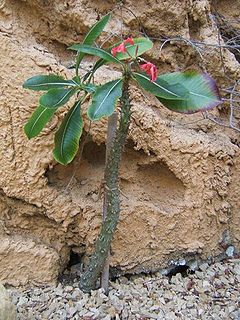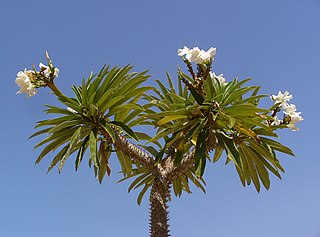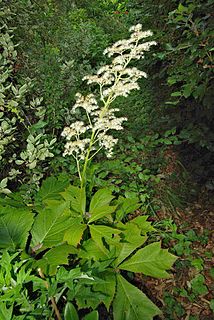Plants belonging to the genus Pachypodium vary widely from each other in some aspects, but also share a number of basic common traits. Each species is adapted to the specific environment which it inhabits, but all species of the genus share certain anatomical and metabolic traits, reflecting their common evolutionary ancestry.
A genus is a taxonomic rank used in the biological classification of living and fossil organisms, as well as viruses, in biology. In the hierarchy of biological classification, genus comes above species and below family. In binomial nomenclature, the genus name forms the first part of the binomial species name for each species within the genus.

Pachypodium is a genus of succulent spine-bearing trees and shrubs, native to Madagascar and Africa. It belongs to the dogbane family, Apocynaceae.
Pachypodium species vary widely in general form, or habit. The genus contains species ranging from the bottle-shaped Pachypodium baronii to the cigar-like Pachypodium lamerei to the branchless dwarf species Pachypodium brevicaule. Most species, however, are shrub or tree-like, ranging in height from 5 m or less to as much as 12 m. All species save one have spines on their branchlets, which are a modified form of stipule; some species have spines in other locations as well. In African species, the spines are clustered in groups of three, two large spines and one small one in the middle. In other species, the spines come in groups of two. The length of the spines varies from 1 to 75 mm.

Madagascar palm, also known as bontaka, is a flowering plant in the Dogbane family Apocynaceae. It has the habit of a robust shrub with a spherical or bottle-shaped trunk. It has several cylindrical branches at the top.

Pachypodium lamerei is a species of flowering plant in the dogbane family Apocynaceae. It is a stem succulent, photosynthesizing mainly through its trunk, and comes from the island of Madagascar, off the east coast of Africa. It has large thorns and leaves mostly just at the top of the plant, and large, fragrant flowers. The species has become one of the best known pachypodiums in cultivation, being relatively easy to propagate and grow. In cultivation it is often marketed as the Madagascar palm, despite its not being a palm at all. A variety called "Ramosum" has been described. It is distinguished mostly by a dwarf growth habit.

Pachypodium brevicaule is a species of plant that belongs to the dogbane family Apocynaceae, which is now amplified by the inclusion of the milkweed family Asclepiadaceae – an important union to botanists and horticulturalists interested in the alliance succulents.
The wood of Pachypodium species is soft and cream-colored; their bark is, on average, 6 mm thick, and often smooth. It ranges in color from dark brown to pale grey to green-grey. In cross section, it is usually green in color.
The leaves may be either sessile—growing directly from the stem—or petiolate—growing from a leaf-stalk. They are typically confined to the apices of branchlets, branches, or the trunk. In most species, leaves range from slightly hairy to smooth on top and densely hairy to smooth beneath. Leaf shape varies, but, in all but one species, upcurving secondary veins are apparent.
Pachypodium inflorescence, or clusters of flowers, appear either at the end of the stem, growing directly off the stem, or attached to the stem by branchlets. The bracts, or leaves surrounding the inflorescence, resemble sepals. Flower stalks range in length from 0 to 56 mm.

An inflorescence is a group or cluster of flowers arranged on a stem that is composed of a main branch or a complicated arrangement of branches. Morphologically, it is the modified part of the shoot of seed plants where flowers are formed. The modifications can involve the length and the nature of the internodes and the phyllotaxis, as well as variations in the proportions, compressions, swellings, adnations, connations and reduction of main and secondary axes. Inflorescence can also be defined as the reproductive portion of a plant that bears a cluster of flowers in a specific pattern.

In botany, a bract is a modified or specialized leaf, especially one associated with a reproductive structure such as a flower, inflorescence axis or cone scale. Bracts are often different from foliage leaves. They may be smaller, larger, or of a different color, shape, or texture. Typically, they also look different from the parts of the flower, such as the petals or sepals. The state of having bracts is referred to as bracteate or bracteolate, and conversely the state of lacking them is referred to as ebracteate and ebracteolate, without bracts.

A sepal is a part of the flower of angiosperms. Usually green, sepals typically function as protection for the flower in bud, and often as support for the petals when in bloom. The term sepalum was coined by Noël Martin Joseph de Necker in 1790, and derived from the Greek σκεπη (skepi), a covering.
Pachypodium flowers always consist of five sepals, ranging in shape from ovate to oblong. The flower is tubular, sometimes narrowing at the top, and varies in color; various shades off red, white, and yellow appear in different species. A hairy belt of varying width appears above the stamens. The tube of the flower varies in length from 9 to 60 mm across the genus. The ovary of the flower is composed of two carpels, each containing numerous ovules. All but two species in the genus have stamens within the flower. When pollinated, the flower produces a pale to dark brown fruit composed of two separate mericaps, which is whitish to pale brown inside when dried. The seeds are pale to medium brown, with a lighter spot on their apex.

In Euclidean plane geometry, a rectangle is a quadrilateral with four right angles. It can also be defined as an equiangular quadrilateral, since equiangular means that all of its angles are equal. It can also be defined as a parallelogram containing a right angle. A rectangle with four sides of equal length is a square. The term oblong is occasionally used to refer to a non-square rectangle. A rectangle with vertices ABCD would be denoted as

The stamen is the pollen-producing reproductive organ of a flower. Collectively the stamens form the androecium.

In seed plants, the ovule is the structure that gives rise to and contains the female reproductive cells. It consists of three parts: The integument, forming its outer layer, the nucellus, and the female gametophyte in its center. The female gametophyte — specifically termed a megagametophyte— is also called the embryo sac in angiosperms. The megagametophyte produces an egg cell for the purpose of fertilization.
All pachypodium species share certain basic characteristics; they use enlarged, spine protected trunks for water storage, enabling them to inhabit dry microenvironments. There is, however, substantial variation on these basic characteristics, and no single shape or pattern of branching is shared by the entire genus. In general, branching is flexible even within a species, allowing each individual specimen to develop as best suits its microenvironment. This adaptability allows pachpyodium plants to occupy marginal microenvironments which provide only limited means of survival.[ citation needed ]










